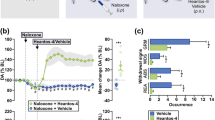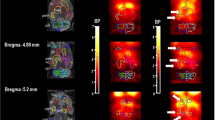Abstract
IT has recently been reported that the rate of synthesis of brain 5-hydroxytryptamine (serotonin) is raised two to five-fold in mice treated by the chronic administration of morphine1. In such mice the withdrawal syndrome produced by the narcotic antagonist naloxone was attenuated by parachlorophenylalanine (PCPA)1, an inhibitor of tryptophan 5-hydroxylation2 which is the rate limiting step in the synthesis of serotonin. This work1 implicated some function of brain serotonin in the development of physical dependence to morphine. Because of the potential importance of this conclusion both in the field of narcotic drug dependence and by implication in the mechanisms controlling the synthesis of brain serotonin we have attempted to repeat this work. Our investigations do not confirm the previous findings and no evidence has been found to suggest an increased rate of brain serotonin synthesis or of an attenuating effect of PCPA upon the withdrawal syndrome produced by naloxone in mice treated by chronic morphine administration.
This is a preview of subscription content, access via your institution
Access options
Subscribe to this journal
Receive 51 print issues and online access
$199.00 per year
only $3.90 per issue
Buy this article
- Purchase on Springer Link
- Instant access to full article PDF
Prices may be subject to local taxes which are calculated during checkout
Similar content being viewed by others
References
Way, E. L., Loh, H. H., and Shen, F-H., Science, 162, 1290 (1968).
Koe, B. K., and Weissman, A., J. Pharmacol. Exp. Ther., 154, 499 (1966).
Jéquier, E., Lovenberg, W., and Sjoerdsma, A., Mol. Pharmacol., 3, 274 (1967).
Siegel, S., Nonparametric Statistics (McGraw-Hill, New York, 1956).
Tozer, T. N., Neff, N. H., and Brodie, B. B., J. Pharmacol. Exp. Ther., 153, 177 (1966).
Ansell, G. B., and Beeson, M. F., Anal. Biochem., 23, 196 (1968).
Marshall, I., and Weinstock, M., Brit. J. Pharmacol., 37, 505P (1969).
Cochin, J., and Axelrod, J., J. Pharmacol. Exp. Ther., 125, 105 (1959).
Maynert, E. W., Klingman, G. I., and Kaji, H. K., J. Pharmacol. Exp. Ther., 135, 296 (1962).
Sloan, J. W., Brooks, J. W., Eisenman, A. J., and Martin, W. R., Psychopharmacologia, 4, 261 (1963).
Gunne, L. M., Acta Physiol. Scand., 58, 204 (1963).
Author information
Authors and Affiliations
Rights and permissions
About this article
Cite this article
MARSHALL, I., GRAHAME-SMITH, D. Unchanged Rate of Brain Serotonin Synthesis during Chronic Morphine Treatment and Failure of Parachlorophenylalanine to attenuate Withdrawal Syndrome in Mice. Nature 228, 1206–1208 (1970). https://doi.org/10.1038/2281206a0
Received:
Issue Date:
DOI: https://doi.org/10.1038/2281206a0
This article is cited by
-
The effects of p-chlorophenylalanine on morphine analgesia, tolerance and dependence development in two strains of rats
Psychopharmacologia (1974)
-
Modification of Precipitated Morphine and Methadone Abstinence in Mice by Acetylcholine Antagonists
Nature New Biology (1973)
-
Morphine Withdrawal Syndrome Responses to Cholinergic Antagonists and to a Partial Cholinergic Agonist
Nature (1973)
-
Modification of Morphine Withdrawal by Drugs interacting with Humoral Mechanisms: Some Contradictions and their Interpretation
Nature (1972)
-
Neuere Anschauungen �ber den Wirkungsmechanismus morphinartig wirkender Analgetika im Zentralnervensystem unter biochemischen Aspekten
Klinische Wochenschrift (1972)
Comments
By submitting a comment you agree to abide by our Terms and Community Guidelines. If you find something abusive or that does not comply with our terms or guidelines please flag it as inappropriate.



